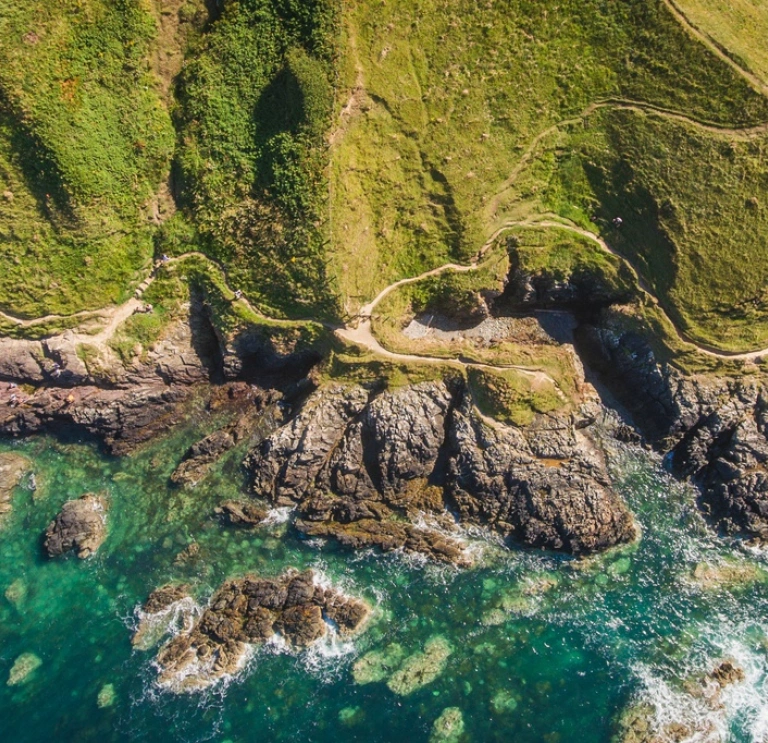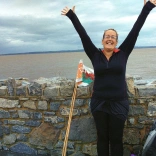Whether you're planning to do the whole path or just walk a short section, it's good to be properly prepared. What to take? What to wear? When to go? Here's a rundown of the important things to know.
When to walk
Welsh weather can be a little fickle and the coast is exposed, so check the forecast. In summer you’ll often walk in lovely sunshine, but the forecast will warn you of any rain showers. Winter might be bleak, but you can take advantage of any good forecasts.
The biggest difference between summer and winter is the temperature and the number of daylight hours. You can walk further in daylight on warm, summer days than in winter. Winter walking works best if you choose short, easy walks on clear, calm days. More services and facilities are available in summer than winter too.
Waymarking and access
When it says Wales Coast Path on a signpost, accompanied by the innovative ‘dragonshell’ logo, you’re going the right way. The coast path is signposted and waymarked throughout, in both rural and urban areas. While most of the route is very obvious, you might need to look a little harder while passing through towns, simply because you’ll find lots of distractions. The path is well maintained with steps, stiles and new footbridges to aid walkers.


Paddy DillonThe coast path is signposted and waymarked throughout, in both rural and urban areas."
Planning and transport
You can make a trek around the Wales Coast Path the greatest challenge of your life by walking it in a single trip, or spread the experience over several years, picking a day or two here and there whenever opportunities arise. Many parts of the coast are low-lying and easily walked so they're ideal if you are not a regular walker. If you are a little more experienced, you'll really enjoy the longer and more rugged cliff paths.

Wales has an abundance of seaside promenades. Towns such as Prestatyn and Rhyl are linked by a stout sea wall. Borth and Aberystwyth, on the other hand, are linked by a popular cliff path. Pick any Welsh coastal town, sample a stretch of the Wales Coast Path on either side of it. It will be a different experience every time, with varied scenery, wildlife, history and heritage.
Many stretches of the coast feature railways, so you can walk from station to station, day after day, operating from lodgings near a station. You can do this along the north coast between Chester and Bangor, around most of Cardigan Bay from Pwllheli to Aberystwyth and along much of the south coast between Carmarthen and Chepstow. The Transport for Wales website has a list of walks you can explore by train.
Read more: Exploring the North Wales coast by train

You can do the same with buses in some places. The Llŷn Coastal Bus and Pembrokeshire Coastal Buses exist to help you plan and enjoy amazing coastal walks without having to double back or use a car. You can plan journeys using Transport for Wales and Traveline Cymru. Some transport apps allow you to track the progress of trains and buses in real time.
For the most part, the Wales Coast Path isn’t affected by the tides, but there are occasional beach walks that are completely covered at high water. In advance of each day’s walk don't forget to check the tide times.
Paddy DillonMany stretches of the coast feature railways, so you can walk from station to station."
Other ways to travel
While the entire Wales Coast Path was made for walking, you can cycle some stretches, and those parts are usually fine if you are a wheelchair user or pushing a buggy. You’ll find designated cycle-ways along the north coast from Chester to Connah’s Quay, Prestatyn to Colwyn Bay or Y Felinheli to Caernarfon. On the south coast you’ll find cycle-ways between Pembrey and Loughor, Mumbles and Swansea, Penarth and Cardiff. These are all integral parts of the Wales Coast Path.
Read more: Top Wales Coast Path accessible sections

Accommodation and packing
If you drive a car to an accommodation base, you can take as much as you want, but carry only the basics along the coast path. This might include waterproofs, windproofs, maps, enough food and drink for the day and a small first aid kit. If you're walking from hotel to hotel you will probably want to include a change of clothes and footwear.
If you plan to camp, then obviously you will need a tent and sleeping bag, as well as a stove, pots and pans if you'll be cooking your own food. You can make use of luggage transfer services to move things between lodgings.
Read more: Luxury Wales Coast Path accommodation
Food and drink
Whether you dine at fine restaurants or grab a bite from a beach snack bar, make sure to sample Welsh food and drink - many places offer local produce or specialities. You'll need to be self-sufficient on more remote stretches, but you should find plenty of shops and delis to stock up on food for day walks with a little planning ahead. As you'd expect, more places are open for food and drink in summer than in winter. You can also get your water bottle refilled for free at hundreds of places along the path.
Visit the Refill website and download the Refill App to find your local Refill Station and get fresh drinking water on the go.


Communications
There are places along the coast where you’ll lose a signal for your mobile phone. If keeping in touch is important, then keep an eye on signal strength. If using a smartphone for navigation and communication, keep it charged and carry a power bank so that you don’t run out of power late in the day. Smartphones are amazingly useful, but less so when you lose a signal and worthless when they run out of power! If you are using digital mapping, carry paper copies as a backup.
Paddy DillonIf using a smartphone for navigation, keep it charged and carry a power bank."
Emergencies
While a basic first aid kit is fine for cuts or grazes, more serious problems might require a call for assistance. The 999 service will link you with any or all of the following: police, ambulance, fire, mountain rescue or coastguard. There's useful safety advice on the Wales Coast Path website.
Further information
The official Wales Coast Path website has lots more useful information, including itineraries and free downloadable leaflets.
The best maps are published by the Ordnance Survey. Landranger maps at a scale of 1:50,000, and Explorer maps at a scale of 1:25,000, show the entire Wales Coast Path. Google Maps is fine for locating lodgings, food and drink, along with other services and contact details, but it won’t show you hills and valleys, or many useful paths, so it isn’t good for detailed navigation. The Wales Coast Path app offers plenty of information that you won’t find on maps.
Downloading the free Wales Coast Explorer app can really enhance your experience of walking the Wales Coast Path. The app helps you identify wildlife, flora, explore heritage sites along the way, and record your findings. You can also become a 'citizen scientist' by sharing your sightings on your walks with local biodiversity information centres via the app.
Guidebooks by Northern Eye, cover the North Wales Coast, Isle of Anglesey, Llŷn Peninsula, Snowdonia and Ceredigion Coast, Pembrokeshire, Carmarthen Bay and Gower, and South Wales Coast. Cicerone publishes a single volume covering the complete path.






